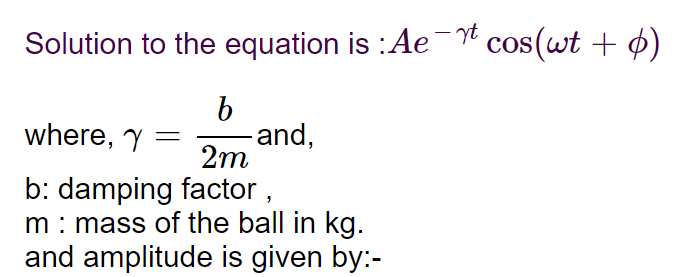Types of Oscillators: Simple Harmonic, Damped and Forced.
Simple Harmonic Motion
Simple harmonic motion (SHM) is a type of oscillating motion. When there is a slight disturbance from the equilibrium or rest position of a pendulum or an object suspended from a spring, it will oscillate harmonically. A small displacement x from the equilibrium position sets up a restoring force that is proportional to x acting in a direction opposite to the displacement, towards the equilibrium position.
F = -kx
This motion is used to model many situations in real world where a mass oscillates about an equilibrium position.
- Simple Pendulum
- Mass attached to a Spring
- Oscillations of a liquid column in a U-Tube
- LC Oscillatorr
In a simple pendulum, a mass oscillates suspended by a light rigid rod or a metallic bob suspended by a string attached to a surface.
A mass attached to a spring that is fixed to a wall.
The motion of an oscillating liquid column in a U tube is SHM with period T = 2πgh, where h is the height of the liquid column in one arm of U tube in equilibrium position of the liquid.
Therefore,T is independent of the density of liquid.
In an electrical circuit, an inductance L connected across a capacitance C carrying a charge q.
The general governing equation for simple harmonic motion is:

- m: mass of the ball in kg, m = 1 kg
- b: damping factor in (Ns/m)
- k : spring constant in N/m
- Fo: Force in Newton (N)
- ω: driven frequency in rad/sec
- t: time period
- φ: phase angle
Free Oscillators
Free oscillations occur when the motion is maintained by gravitational or elastic restoring forces, such as the swinging motion of a pendulum or the vibration of an elastic rod. The simplest type of vibrating motion is undamped free vibration.
Some examples of free oscillations are oscillations of simple pendulums, horizontal oscillations of objects connected to a spring, sound produced by tuning forks at short distances, notes of musical instruments, organ pipes, etc.
Nature of Free Oscillators
Under free oscillations, the amplitude and frequency of a freely vibrating body remain constant. They do not lose or gain any energy in the process.In this type of motion Fo, b (damping factor) = 0
So the equation(1) is :

where,
• The solution of the equation is: Acos(ωt+φ)
which represents simple harmonic motionωo is the natural frequency of the system:

Example: spring-mass system and tuning fork.
Damped Oscillators
In damped oscillations, the moving particle gradually loses its kinetic energy on interaction with resistive forces like air or friction. Due to this resistance offered by external forces, the displacement of a particle slowly reduces with time and ultimately reaches its state of rest.
Example:
Shock Absorbers
If the damping force Fo ,is proportional to the velocity vo, with a damping constant b, then
Fo = -b𝑣o
The equation of motion (1) becomes:



ωo is natural frequency of the damped system and ω' is the frequency of the damped oscillator.

b2 = 4km
b = 2√2
Under certain conditions damping is of three types:-
1.Under Damping
When damping is small, the system vibrates at first approximately as if there were no damping, but the amplitude of the oscillations decreases exponentially.
Example :A swinging pendulum decreasing in amplitude until it comes to a stop.
Under damped oscillations: b < 2√2

b: damping factor ,
m : mass of the ball in kg.
and amplitude is given by:-

2.Critical Damping
When a critically damped oscillator is displaced from the equilibrium, it will return to rest at its equilibrium position in the shortest possible time without oscillating. Critical damping occurs when the position of the mass asymptotically approaches zero. Depending on the initial velocity, it will either go monotonically to zero or reach some maximum displacement before it turns around and goes to zero.
Example: Car suspension systems prevent the car from oscillating after travelling over a bump in the road.
Critically damped oscillations: b = 2.8
3.Over Damping
When a heavily damped oscillator is displaced from the equilibrium, it will take a long time to return to its equilibrium position without oscillating. When damping is that large, the system does not oscillate at all.
Example:Car suspension systems prevent the car from oscillating after travelling over a bump in the road
Over damped oscillations: b > 2.8

Forced Oscillatorss
Forced oscillations occur when an oscillating system is driven by a periodic force that is external to the oscillating system.
Example:-Applying force on an oscillating pendulum or turning off a radio.

here
ω: driven frequency for forced oscillations.
Fo:force for the forced oscillatorResonance
If the forcing frequency is close to the natural frequency of the system, and the system is lightly damped, huge vibration amplitudes may occur. This phenomenon is known as resonance.
-
1. musical instruments (acoustic resonance).
2. Most clocks keep time by mechanical resonance in a balance wheel, pendulum, or quartz crystal.
3. Tidal resonance.
4. Orbital resonance as in some moons of the solar system.
5. The resonance of the basilar membrane in the ear.
6. Making a child's swing higher by pushing it at each swing.
7. A wineglass breaking when someone sings a loud note at exactly the right pitch.
-
There are some other types of oscillations, such as:
The related equation is:
Additional Information:
Coupled Oscillators
Coupled oscillations occur when two or more oscillating systems are connected in such a manner as to allow energy to be exchanged between them. Coupled oscillators occur in nature (e.g., the moon and earth orbiting each other) or natural pacemakers in the heart..
